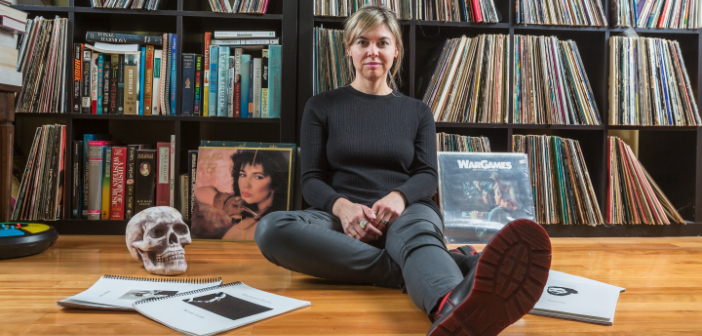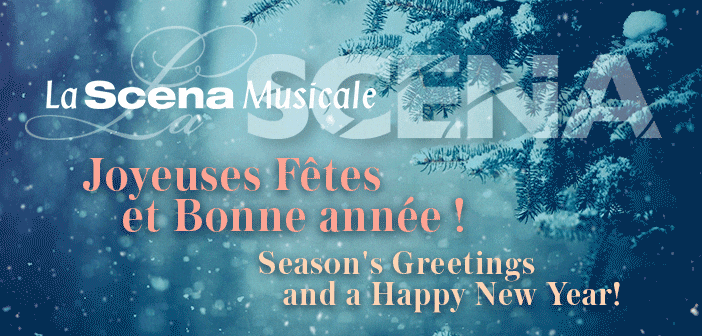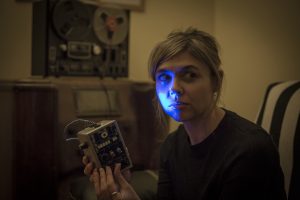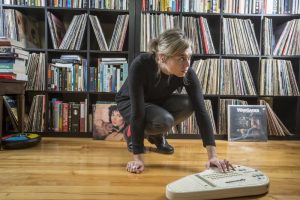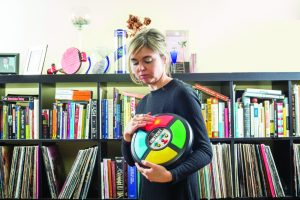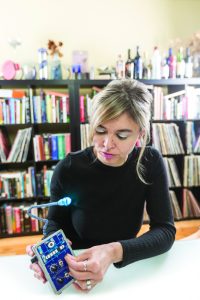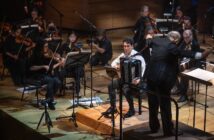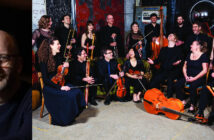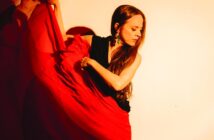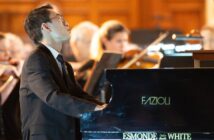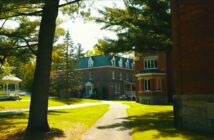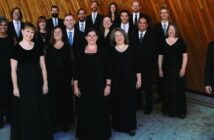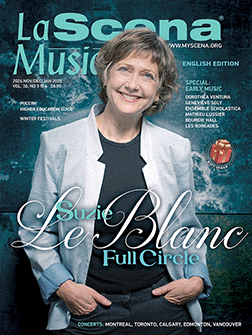Back in January, I interviewed Montréal-based composer Nicole Lizée for the cover of the February/March issue of La Scena Musicale. We had a long and involved conversation, covering many topics that simply could not make the print article due to space constraints. In light of the evening of her music last night with Standing Wave at the SMCQ’s Montréal/New Musics festival (which runs until March 4), I thought it would be interesting for my own sake to return to our original interview. But that’s when I realized that there’s a lot more in there that could be relevant to those who are interested in her music.
And, hey, the transcript already existed.
Fair warning: It’s quite a long read not for the faint of heart or for the pressed for time. When we were wrapping up the interview Lizée said, “It feels like I’ve been talking for two years.” As a matter of fact, it took me longer to transcribe the interview than it took to write the article, which you can read here.
Some of my favourite moments of the interview include the discussion about the ET Video Game, Denys Bouliane conducting a concerto for turntables underneath a student’s bed, how percussionist Ben Reimer learned to play the double-kick pedal, and the SaskPower lollipops. Lizée talks about technology, nostalgia, notation, inspiration, and art – she even graciously answered my question about her favourite bands. Near the end of the interview, Lizée gets into particulars about how she positions herself relative to the academy and gives some advice for aspiring composers.
I hope you enjoy our conversation as much as I did!
Kiersten van Vliet: We’re running this cover article in collaboration with the Montréal/Nouvelle Musiques festival, but I went on their website and they don’t have a program up yet. I was wondering if you could tell me your role in the festival and how you came to be involved with it this year.
Nicole Lizée: So you haven’t seen a program? Okay. Well there’s a night devoted to my music. A group from Vancouver named Standing Wave is performing a night of my music. Three pieces all include analog electronics. The whole evening is a celebration of analog and the fact that it’s becoming forgotten or erased or lost and gradually being replaced by digital.
Much of my aesthetic is celebrating and reviving analog devices, sounds, and equipment – finding old equipment that was once the height of technology, you know, in the ‘60s, ‘70s, and ‘80s, and, of course, has since been replaced by digital for many reasons. One of which: some of these analog devices worked to a point and then they would start to malfunction. Some of them didn’t work very well but I grew up around these devices.
The thing about analog [devices], unlike digital, they don’t die; they actually have a much more interesting life after they start malfunctioning. I use this equipment within a chamber ensemble, I notate it and harmonize it, and members of the ensemble have to learn how to play it, so I devise a way of playing it like a violin or a vibraphone or any other instrument. So it becomes a part of the chamber ensemble.
So this whole night is devoted to that.
KvV: Do you have the names of the pieces?
NL: Yep. One of them is called Ouijist. [Spells it]. That’s from 2013. The second is called Hitchcock Études.
The first piece is for four players and spectres. The second is for chamber ensemble and glitch, six players I think.
The third piece is called Sculptress, and again, for chamber ensemble and vintage machines. So I wrote it using reel-to-reel, stylophones, omnichords, and devices from the past. It’s an homage to Delia Derbyshire, who worked for the BBC in the ‘60s in their radiophonic workshop. She worked in secret at night doing these experiments. And this music doesn’t quote her, but it’s harnessing the spirit of her, creating new sounds and new perspectives using analog media and merging it with a modern chamber group and absorbing these sounds into the sound of a violin, and that sort of thing.
Hitchcock Études is part of my collection I call the Criterion Collection and it references auteur theory, and it is a celebration of, or homages to, film directors that I’ve loved since a very young age and those that have made a huge impact on my aesthetic. There are four of these so far in the series, and this is the first one, Hitchcock Études.
The premise of the piece is watching the Hitchcock films over and over like I did when I was a kid. Watching them on tape, they would degrade and get chewed up, but I would still watch them. Because they were analog, they were tape, the colours would saturate and rhythms would start happening and different scenes would get cut up and spliced.
Ever since a young age, I loved the way it looked and sounded, so this piece takes that idea, and, again, I treat the film as if it were a member of the ensemble. So the ensemble is in perfect sync with it. So I notate it, there’s a click track. So there will be malfunctioning video alongside the malfunctioning ensemble. So the ensemble plays glitch, sort of glitch for live ensemble.
KvV: So is there an element, would you say, of nostalgia in your aesthetic, in keeping these devices that are outdated and have been remodeled and they might have been thrown away at this point, discarded?
NL: Yes, I would say that nostalgia is part of it, but there’s a little bit more than that. Some of these instruments, for example a stylophone, I only discovered a few years ago and really didn’t know it existed. And it’s very hard to find, especially at that point. I had to order it from China and I waited for three weeks for it to arrive by boat. When I finally got it I was so excited.
It is nostalgia, but there’s something about – not that I don’t like digital, because I use digital – but it’s something about these old devices that have a very specific sound, they’re very tangible, you manipulate them like an instrument. For some of them, they’re not intended to be in the concert hall, they’re not intended to be instruments.
I’m finding it’s a recontextualization of things, bringing them in: a string quartet merging with a stylophone or merging with an omnichord or a reel-to-reel machine is a different sound world. A sound world that speaks to me because I grew up around, my father was a salesman and collector and technician of machines – and he would keep everything, and of course, all of them are malfunctioning. So all of these oscillators, all of these game consoles and everything are considered instruments or sources of sound the same way that a piano is, or a guitar is, that I also grew up around. Bringing these two worlds together is very natural.
So it’s a little bit nostalgia in that it came from something I grew up around, it’s from the past. But I’m always finding ways to bring it into the now, rejuvenate it, and bring new life to it. Even the characters in Hitchcock, a lot of young people when they see this performed, they have never seen a Hitchcock film. A couple of things are happening: it’s bringing to life these characters, but not only that, bringing them into the concert hall, which is an unlikely place for them to be. What happens is that the performer plays with the character on screen because everything is so meticulously notated. There’s a dialogue going on. So Norman Bates, I built an Étude using his stutter, and that’s a very unlikely basis for a musical work. Bringing Hitchcock characters into a concert hall and making music out of them is very important to find other sources of music.
KvV: So for you, a lot of it is finding new sound worlds and expanding what we might consider concert music, or what we might put in the venue of the concert hall?
NL: Yeah, like that, but reflecting what I think of as music. Hearing from the age of, I don’t know, five years old, hearing that stutter over and over. And on that same tape that stuttering coinciding with a stuttering tape. This is a great sound. For most people that would be a bad sound and now you have to discard the tape and buy a new one. For me, this sounds amazing and I can’t help but pair it with a vibraphone, or pair it with a drum kit.
For me, everything is potentially music, but it’s not just arbitrary, it has to be something that has a lot of meaning to me. Seeing something like Norman Bates’s stutter has been in my head ever since the age of five, the same way the sound of a piano has been in my head since the age of five. So it becomes part of my sound palate.
So yeah, bringing all of these sounds that I think are completely part of the palate, they seem natural being together. Building a piece, a concerto for this stutter is expressive for me, yeah.
KvV: It’s interesting, it’s almost the opposite way – or maybe not the opposite way – it’s not the way that we’re sold to interact with electronic media and these sorts of devices. With the replication and mass production of them, we’re supposed to look for uniformity, but you’re looking, and you’re finding maybe not beauty but interest in the individuality of these devices.
NL: Exactly. And I do think of this as beauty because as a kid watching these colours when they would saturate, it looked beautiful. And I built a piece on one of the first films I saw – The Sound of Music. Of course I saw it over and over and over and over. And eventually it would degrade and turn into this psychedelic experience. A few years ago I built an orchestra piece called Behind the Sound of Music which turns The Sound of Music inside out and celebrates all of these mistakes, all of these glitches, that are beautiful. There’s something about even the hiss and hum and static is a beautiful sound.
What happens is that the tape, the film, the characters go into a portal, go into a different world. I’ve sort of describe it as when you have a fever dream, or you’ve been in the sun all day and you’ve been listening to a tape and at night you’re dreaming about it, it’s going through your head, but your mind is taking it somewhere else, it becomes more vivid, becomes unpredictable, and it becomes – I use the word psychedelic, because the word is so evocative of many things. I want to stop time in this moment, this film, and take it into a portal of where it could go and celebrate the malfunction. Because of the malfunction, we’re being taken into a different world.
KvV: On your website you describe it as “hauntology” or “musical hauntology.” You’re interested in ghosts, or finding these ghosts and interacting with these ghosts. Does that also influence the types of sources that you use? You mentioned that you like watching Hitchcock over and over and over again. Do you always use things from your childhood or your past? What do you look for in your sources other than, perhaps, these glitches? What makes a source or a material interesting to you, the subject, or—?
NL: I think many things. It’s not just from my past. My past is part of it just simply because there’s such a rich history of art and sources that are not necessarily viewed as art to begin with. I want to bring it into an artistic place.
But also, things like ghosts. There’s something about things that were so important to so many people at one point in time and then they were quickly forgotten or replaced or put in a landfill. There’s a lot of connotation, there’s a lot of attachments to these things for me and for a lot of other people. I’m primarily writing for myself, I’m remembering.
I wrote a piece several years ago for the ET Video game. I don’t know if you know the story about the ET Video Game, but it came out in the early ‘80s. It was a really frustrating game to play and it was quickly considered a failure so all of the cartridges were placed in a landfill in New Mexico, I think it was – thousands and thousands of cartridges.
But I still played this game, I had no idea that it was a failure, being 8 years old. It was a really frustrating game, but the point wasn’t the game, it was: “What is this, what are these formations, what is this world that someone’s created? This pixelated, raw, gritty…” There’s nothing else that looks like this and you’re completely absorbed in it. And then it’s gone.
Then a few years ago they had a special event where people around the world demanded that they dig up, finally, 30, 40 years later, these cartridges. Thousands of people gathered in New Mexico and there’s actually a documentary about this, and they waited there to see these cartridges get dug up. And they finally got to them, and they were pretty deep in there, and yeah, they took pictures and there’s footage online.
So there’s something about these…they’re ghosts. They’re things that once existed. And they meant so much to everybody and then they disappeared. And then what? What happens when you find that ghost and you bring it into a work of music?
I don’t just want to find it, and say, “Okay, I have this cartridge, I have this game again.” There’s a lot going on in this, a lot of emotional ties to it, but what can I do with it to bring it into what I do, which is create music. So then I find a way to integrate it into the concert hall and treat it in a way that it wasn’t meant to be treated.
Things like that, things that have disappeared, bringing them back…but not just bringing them back but finding interesting ways of merging them in a concert environment.
KvV: You mentioned a conversation with the performers. What is the role of the audience, do you find? I mean, it’s probably different for each of your works, but where do you place the audience in this?
NL: The audience? That’s entirely up to them. I can never predict my audience’s reaction or who my audience is going to be because it’s been such a wide demographic. And it also depends on geographic location. Something like the Delia Derbyshire piece, the BBC piece, when it was performed in London had a very different reaction from when it was performed in Montreal. So I can never predict.
I also never know, for example, following a performance of Hitchcock Études, some people will know every Hitchcock film and come up to me and say, “I didn’t expect that, that’s crazy.” They know every moment so to be taken, suddenly the piece, the scene stops and is flipped, distorted, and taken in…it’s interesting to hear what they went through.
I’ve had younger people come up to me who were really into the piece but they’ve never seen a Hitchcock film before, but are going to go watch Hitchcock now.
For the musicians, it’s really interesting because the musicians have to have these sounds that are really manipulated, they’re intense, happen in their ear, because they use a click. There’s a click and the soundtrack in their ear and they’re practicing with this and they’re working, working with this. It gets inside of their heads, it’s emotionally chilling.
The second [in the series]is Kubrick Études. My percussionist, just a little while ago, said, “You know, one of the Études, every time that I hear it, I freak out.” He’s visibly shaken because the character’s personalities are in there, that are playing, and they’re kind of sinister and some of them are even psychotic because I’m working with horror films.
One of the musicians a while ago was playing Hitchcock Études and hadn’t seen one of the films, The Birds. She’d never seen it. With The Birds I use this chant in the schoolhouse. There’s no music in this film, which is really interesting: Hitchcock decided not to use music. But there is this one chant that the school children are singing just prior to being attacked by the birds. I take this chant and I extend it and build it into a chorus, a choral kind of thing. She had never seen the film, she played the piece, it was completely in her head first and then saw the film. I got an email or a text from her saying, “Oh my God!” It was kind of the opposite. She had experienced the piece first and then the film, so it played with her head in a different way.
But as far as the audience, the audience’s reactions are an enormously interesting part of this. You never know what the reactions are going to be because a lot of people have had different experiences with different things.
KvV: You say it’s a wide demographic. Have you found that your integration of other types of media into music has broadened your audience that might not be interested in going to an “Art Music” or “New Music Composition” concert?
NL: It’s hard to say. I don’t really know. I’m just so involved in creating the pieces, and I also perform in the pieces quite often. It’s hard to tell. I’ve done this for a while now, so it’s different between the way things were 10 years ago compared to now.
I know that I’ve had these pieces played at film festivals. I get a lot of performances at film festivals because they have great venues now and a lot of great sound systems and, of course, an amazing screen. That’s been great: to see a film audience’s reaction. Maybe then, they would possibly not go to a concert music concert.
There’s always a mix, which is my favourite audience. I love to see people who love film and music. Film festivals, and just festivals in general, are a great opportunity to get people from a wide demographic to go and check things out and listen to music and watch visuals together.
KvV: You say you’re often an active performer in your pieces. You play the turntables?
NL: I play turntables, I play keyboards, and I play the vintage electronics like the omnichord and the reel-to-reel. I’m surrounded by a few things on stage.
KvV: Is your art music background in keyboard?
NL: Yes, that was my first instrument when I was very young and then I added guitar. When I was about thirteen I learned how to play drums and just started adding instruments as I went.
KvV: Were you playing pop music when you were adding the drums?
NL: That’s the interesting thing, no. Growing up, my parents had a huge easy listening record collection and soundtracks – thousands of records of the Easy Listening genre and film soundtracks and some classical too. I took piano lessons from a very young age and I started playing by ear for a few years, and I started taking lessons later and it was always classical.
But at the same time, I discovered MTV, around the age of 10 or 11, when it first came out. And my parents were playing these records all the time. My exposure to music was wide. I loved classical music. I loved easy listening and soundtrack music. And I really got into pop music, and rock, and really got into heavy metal, actually, when I was in my teens.
KvV: What were your favourite bands as a teen?
NL: When I was really young, I first got into the New Wave stuff like Duran Duran and Culture Club. Then I got full-on into metal: Motley Crüe and Iron Maiden. And then that started sounding too light, so I started getting into Megadeath, Anthrax, Metallica, Stormtroopers of Death and Corrosion of Conformity.
Then everything started to sound a little slick, this is the late ‘80s now and MTV is starting to get kind of formulaic, and everybody was copying each other in metal. So the stuff that I loved the earlier ‘80s like Motley Crue, I got sick of it. That’s when I got into the counterculture: I got into Kate Bush, Red Hot Chili Peppers, Depeche Mode, and the Smiths, stuff like that.
Plus, my friend had loaned me her father’s Led Zeppelin album, the first four records. I really got into stuff from the past. I got into Led Zeppelin, Pink Floyd, the Beatles. I mean, you hear the Beatles as a kid here and there, but actually sitting on your own with the headphones on listening to Revolver or Rubber Sole from beginning to end is a thing you have to do on your own, and that’s what I did when I was about 16, 17.
Also I actually got into – because I was still into guitar – but I got into shredders, this phenomenon that existed where you could buy CDs or tapes of guitar players just playing a lot of fast, crazy guitar. I was really into that.
KvV: And you decided to go into university for music. Did you go into university intending to be a composer?
NL: It just happened. I knew that I wanted to continue making music, and I wanted to compose. Where I went, there was no composition department, so I auditioned as a pianist without any plan. I just knew I wanted to continue doing what I was doing, which was writing and playing a lot of different kinds of things.
I mean, genre really had no— I had no boundaries. I was so open: I didn’t know where I was going. For a while, I was going to be a heavy-metal drummer, or I was going to do experimental soundtrack work for TV shows or movies, or I was going to go and work with Kate Bush.
I was just really open to sound. So I knew by going to a music school – this was of course 1991 and it was very classically-based – but I knew I was just going to learn more and be able to play more music and be surrounded by other musicians. So there was no real plan, that way. And eventually, they had a composition department, so I did both.
KvV: Did you go right into graduate work at McGill, or was there a bit of a break?
NL: I graduated in, this was at Brandon University where I did my undergrad, then I decided to go to McGill. There was a bit of a break because I graduated in the middle of the year. So I did a lot of writing in between that. But I went the next year, in ‘96 and moved to Montreal and went to McGill.
KvV: And your writing at that time, in between your Undergraduate degree and your Graduate, was it the same as what you’re doing now, was it a little bit different?
NL: Oh, that’s a long time ago! It’s very different from what I’m doing now, but sort of in the same spirit. I mean, I always knew what I wanted to do and I never really followed any one style or any person or anything like that. I just sort of did what I wanted to do.
I guess, the writing that I did then was just trying to experiment. Trying to get a grasp on different kinds of instruments, on notation. So, very different than now because I’ve spent so much time in the past 10, 15 years transcribing crazy things like a man’s stutter. You know, trying to transcribe a stutter –
KvV: So you actually notate that in a score?
NL: Yes. I notate that. Since then I’ve done David Lynch Études, I’ve done Kuberik Etudes, I’ve done Tarantino Études. Anything that is glitched and that I want to include in a piece, I have to notate it. The point is that it must exactly coexist in a chamber piece alongside the other instruments. And if there’s a conductor involved, I want the conductor to be able to – you know, everything has to line up like any work.
So yes, that has been crazy amounts of transcribing. And transcribing the un-transcribable.
KvV: So have you invented new notations for your work?
NL: Yes. I started doing that at McGill, actually. When I started working with turntables, I devised my own turntable system. Back then, in order for me to do what I wanted to do, I knew I had to communicate this in some way, and that way is notation.
Simply, ever since then, all of the devices I have brought into chamber music and the concert hall, each one has had to have a device made for it. The omnichord, the stylophone. The omnichord, the first time I wrote for it was a for a piece for Kronos Quartet, where they would play their instrument, put it down, play the omnichord. It’s complex, there’s a lot of depth to that instrument and so I had to devise notation systems so that it’s read and kept in time and synchronized with the other players. When Hank, the violist performs on the omnichord, it’s very specific and it’s in time with everybody else who’s harmonizing with it.
Anything – the stylophone, the reel-to-reel, the stutter, Robert Blake’s laugh (I don’t know if you know Lynch’s Mystery Man in Lost Highway), I made an Etude on his laugh. Or, Naomi Watts’s inhalations in Mulholland Drive. There’s a scene – it’s a split second, well, two seconds – and it’s a crazy scene, and she inhales. And the way that she inhales, there’s a rhythm. She’s going through something, she’s becoming psychotic. So I took this, notated it, and made it into a part so that the pianist can perform completely in sync with it.
So, notating all of this stuff has made me a little crazy.
KvV: Yeah, I was going to say: Is it disturbing?
NL: [Laughs] It’s not quantized, life. Life isn’t quantized, nor are these things, but I want them in there. This is a lot of what I do, because I want these new instruments, I have to create a new notation for them.
KvV: And you say that you got into turntables in your Master’s degree at McGill. Do you remember the moment when you decided to do this?
NL: Oh, I was into turntables way before then. We had a lot of turntables in our house – of course, not the DJ-style turntables, the bell-style turntables – I would play with them as a kid, not knowing – this was in the ‘70s – and had no idea because I was so geographically isolated, not knowing what was going on in New York.
But I mean, nobody really knew. The only time I knew was when MTV had this special on turntables about what was going on in New York in the early ‘80s. This t had been going on for a few years, but under the radar. I thought that was incredible. For me, when I was watching this, I was thinking, “This is the epitome of creativity.” Where you’re using something that was never made to be used this way and making music out of it, which is – you know – what I’ve done. It’s essentially what I’ve based my whole aesthetic on: coaxing music out of atypical places.
I was totally into turntables back then, all of the early turntablists. When I moved to Montreal, I decided it was time to do a thesis. Now I have some notation skills, I’m going to do one on turntablism. I’ve always loved this and, like I said, it represented real innovation. So I wrote my first turntable concerto then. I did it without ever knowing any turntablists who could read music. I just dove in. I could do some stuff on the turntables, I was originally going to write for a DJ setup for somebody with real skills, really going in there. I was also experimenting, looking at other kinds of turntablism as well.
But anyway, so I wrote it, again transcribing the exact moments on the records I wanted since this was with orchestra, so everything had to line up perfectly. I then wrote my thesis on it, went into detail.
So it was done, and I remember this day. I went to the cafeteria at McGill. I’m with my friends and exhausted. My makeup is running because I’ve just been working on this for…forever. I was like, okay I’m finally done this, but who the hell is going to play it? I never thought of that, I just knew I wanted to do it and I would worry about that later.
I remember this moment, the caf is full of people and my friend looks at me and says, “What about Paolo?” You know one of those moments when the video, moments where it gets dark [and things slow down], “Where’s Paolo?” Her finger pointing across the caf. And I looked over and there’s this guy – this is 1998, keep in mind – in the corner and he was wearing this big puffy silver coat. I went over to him and started talking to him. Well, no…I didn’t talk to him, the first thing I said to him was, “Hey, do you want to play my turntable concerto?” And he said, “Yes, yes I do.” And that’s how we became lifelong friends. He went [to McGill]to study trumpet so he read well and he was also a turntablist.
I gave him the part and the conductor wanted to make sure – because the conductor was like, “What the hell is this?”
KvV: Who was the conductor?
NL: The conductor was Denys Bouliane.
KvV: Who was your advisor?
My advisor was also Denys Bouliane.
So I was talking about the story. We all met at his apartment and the thing is, Paolo had roommates so his turntables were underneath his bed. He had one of those loft beds. And his turntables were underneath his bed.
I have another snapshot memory, a videotape memory of seeing Denys Bouliane conducting Paolo in his bedroom, underneath his bed. And, incredulously, this thing that he’s seeing notated – record juggling and the pitch shifting and everything – is actually going to happen. It’s a moment that Paolo and I always laugh about, ‘Cause it’s pretty funny; like, Paolo’s underwear all over the floor and here you have this conductor. It was pretty cool.
So anyway, that’s how that was born. And since then, I’ve written several pieces for turntables. Most of which have been for Paolo, he’s an amazing musician. Incredible skills. We get along well. We talk about old ‘80s R&B, obscure stuff, for hours and hours and hours. And each piece I write for him, it just gets more and more virtuosic, and bigger in scope, and he can do anything, really.
KvV: Is there anyone else working for turntables in the same way?
NL: There are some things going on, but it’s not really notated in the same way. The way I notate is really meticulous. There’s no – not to say that there’s anything wrong with improv, because that’s where it came from and improvisation has [developed all of these important things in music], another instrument that I write for often, drum kit, has all of these things from improvisation – what I wanted to do is harness the spirit of improvisation while composing for it and finding new ways for it.
So, no. I’ve seen a couple of notated things, but it’s very [limited]; it’s a chart or cues.
KvV: So you’re fundamentally still composing in a traditional sense. You’re still putting pen to paper – I mean, you’re transcribing – but you’re still –
NL: Yes. It still has to go on paper in order for it to be communicated to players. At some point, players and musicians have to know what to play. So, yes. I keep the notation as rhythms and pitches, but there has to be a lot more information on the page that I have to make up, just in order to communicate what I want to happen. When that involves something that has a turntable where you can shift the pitch, one hand can do one thing, one hand can do another thing, you can go in reverse, these kinds of things I simply had to find a way to express that.
The way to do it is words, there’s words. Sometimes there’s pictures. People will still contact me if they want to perform my pieces and they’ll want to know this information, so I have to put that in the part as much as I can. It just means a lot more – besides the pitches and the rhythms, which are essential – there have to be some words and some diagrams.
KvV: In 2008, you produced a record This Will Not be Televised, can you describe that process and what brought that project to be?
NL: Oh! That seems like such a long time ago. I was contacted by the producer from Centrediscs in Toronto, and he said, “Have you ever thought of doing a record?” And, I mean, I’ve thought about doing a record since I was five, my dream was to do a record. And he said, “We’ll put out a record.” So, great! So, putting out a record of essentially classical music, that does imply many people. So you have to raise some money, so that took some time.
This Will Not Be Televised, the title track, actually two of the pieces on the record, and rpm – rpm is my thesis piece, so that’s my first concerto for turntables – and This Will Not Be Televised is the third piece that I wrote for turntables. Both of those pieces were recorded live in concert and sounded amazing, so we didn’t have to re-record those. We had to get the masters and we could use them. I was lucky that way.
And then the rest of the album is smaller pieces. At that time, this is early 2000s, and I wanted to work in what I called a “small jazz chamber group” of five players. I initially played with jazz players because I really wanted to get into groove and really try things out with drum kit. And delve really deep into – well, again jazz comes from the oral tradition, there’s improvisation, which I love, but as a composer, I want certain things to happen and I don’t want it to be all feel and groove-based. I want to look into polyrhythms and things like that.
So that’s what the rest of the pieces on the album were. And we recorded those in one day. Yeah, it was insane.
Actually, this is an important moment because I had met Paolo years before, and Paolo was so great. And then I met Ben Reimer, who’s another really important musician and friend to me. At the time that we met, he played for the WSO, and This Will Not Be Televised was being premiered. Whenever I write drum kit parts for an orchestra, I was doing it then, and I was like, “Ah! Why do I do this? Why do I do this?” Because it’s tricky to play drum kit.
A drum kit player really, a lot of them can do it, it’s just this part especially, I was just like, “Okay I’m just going to go for it. I’m just going to write this drum kit part.” I was really getting into trying things out using drum kit. So I’m sitting there and the piece starts and I look over and I’m like, “Who is this guy?” Because it sounds amazing.
That’s when I, you know, looked at him and was like, “Well, I have to work with this guy again.” And we started working together and have not stopped. The guy is really singular, there’s nobody else like him. He commissioned a piece from me the next year or something. He also pushed it to do double-kick stuff.
This is the story I remember. I didn’t know him that well but I sent him an email saying, “Do you play double kick?” I really wanted to use double kick because that’s a completely different world.
KvV: It’s pretty metal.
NL: Yeah, exactly. [laughs] My metal roots are shining through; I can’t help it! So I asked him and he said, “Yeah.” And what he tells me, years later, is that he didn’t, but he went out that day and got double-kick pedals.
KvV: He didn’t want to disappoint you!
NL: Yeah! Which is awesome, because I wrote this double kick stuff. I took a glockenspiel and put it where a hi-hat or snare should be and wrote really elaborate grooves interspersing high-hat with glock. Treating the drummer like a DJ, where the brain is split. What I love about drummers is that they have four limbs and they’re completely independent of each other. They can do a lot of things: they can split their brain four ways. Especially Ben, the guy’s incredible.
So one person is playing these really precise, really intricate parts, going between glock and high hat and kick drum and playing double kicks at the same time as playing melody. This is something I’ve always wanted to do: bringing things together.
The glockenspiel has existed for a very long time, but it’s had this role. One person plays the glockenspiel, not too many notes. Go onto another instrument, that kind of thing. For one person to play double kick drum and glockenspiel at the same time, there’s this melody and this groove going on simultaneously. And he could do it.
So I’ve since extended that to other things with double kick pedal in place of snare. Like doing blast beats. They’re very hard to do, but they sound amazing. So the sound potential is massive. So doing blast beats, instead of on a snare, having some pitched guitars. So you have this melodic presence at the same time you have this blast beat groove.
I’ve done the same thing with portable turntables with a record on them. The record is spinning and he’ll hit the spinning record as part of his drum kit. Instead of a snare, for example, you have the sound of the mallet hitting the turntable repeatedly. You hear this groove, you hear where the snare would hit in a drum groove, but it’s this different sound.
I’ve written concertos for him. He just recently recorded one of my recent concertos that’s coming out pretty soon. Yeah, he’s incredible.
KvV: So you have a recording in the works. Have you any desire to record another album?
NL: Since This Will Not Be Televised, I did Bookburners in 2014. So that’s where the pieces that are going to be performed at this concert and this festival, two of them are on there. Hitchcock Études are on there. It alos includes the video of the Hitchcock Études. And actually Sculptress is about to be released next month by Standing Wave on a Vancouver label, Redshift records – but I’m not sure.
With Bookburners, I lived the dream of actually putting out a vinyl record. That’s what I wanted to do ever since I was five years old. That was a great day: smelling my record.
I want to do that again. The cool thing is that with every record and every project and every year, I’ve accumulated this great roster of players that want to do stuff. They’re players and they’re creative and they share my vision of putting out cassingles or putting out vinyl and thinking about the artwork, things like that.
I know that in the new year – I’m also in a band – and it’s interesting because we’ve been doing a lot of shows, we just did a tour in the Fall.
KvV: What’s the name of the band?
NL: SaskPower. We have shirts, we sell these shirts. We have suckers with the SaskPower logo. But we don’t have any record at all at our merch tables.
And people are all around our merch table and there’s no records, okay, but there’s this shirt and this sucker and this button. People are asking about our band but we just do shows. There’s no record by we tell them to go buy a sucker at the merch table.
So that’s our plan, to go into the studio and record this stuff. And we finally get to do it in the spring.
KvV: What does your 2017 year look like other than this and the festival?
NL: 2017 is crazy. I’m going to be going to Australia in about a week for the Sydney Festival. That will include David Lynch Études. 8-bit Urbix, which is also being performed at the Montréal/New Music festival by the McGill Contemporary Music Ensemble.
That piece was commissioned by a group in Australia, and that premiered last spring so they invited me back this year for this festival. And also the third piece is called Karappo Okesutura, which is my take on karaoke. Using karaoke tapes and glitching them and splicing them and messing with them, shift pitching and everything, and having a karaoke singer sing along with this new rendition of a pop song. And, of course, there’s a karaoke video that’s also glitched and malfunctioning and distorted and melting.
This is taking the glitch that I was talking about before and extending it to include a singer. So the singer has to jump pitches and jump rhythms and tempos really quickly. It’s a pop song so people know the song, but they don’t know this song. And of course the lede vocals in the karaoke tapes are taken out, and the hand claps and background vocals are twisted and pitch shifted and melted. That was played in Australia last year and they want it back again.
I’m going to the PuSH festival in Vancouver. There’s going to be a new premiere by Ben Reimer and Vicki Chow from Bang on a Can, the two of them and video. And then there’s another festival, where the same group, Standing Wave will be playing in Vancouver. I will be playing with them on vintage machines.
There’s also a new piece for the Toronto Symphony Orchestra with the Kronos Quartet as soloists, and film. It’s called Black Midi. It’s a 20-minute melting documentary of Black Midi that I’ve created. It’s along the same line as Hitchcock Études and Kubrick Études, where I use scenes that become distorted and glitched, but in this case I’ve created the scenes and they’re all based on this phenomenon called “Black MIDI” and what it might mean. So it’s sort of goes into a surrealist dream world. So that’s happening at the New Creations Festival in March.
And…yeah. There’s more, I could keep going.
KvV: That’s great! I just wanted to wrap up with a few general questions. How do you view the role of the academy in new music compositions? You’re someone who, I assume, is very much outside of the University system at this point. Do you have any desire to be in it?
NL: I don’t really think about it. I don’t have time to think of it. I go and do guest lectures and do presentations and talks, which I enjoy doing. The way I’m working now, I don’t think about it. I’m always working; I have to try and meet deadlines and things like that.
I just spoke to a group of students. You’re in a university and you’re surrounded by people and your professors who know a lot. You’re surrounded by information, essentially. And when you’re a young person there’s a lot that you can learn, of course. If anything, you have a convenient library just full of music. When I first discovered the music library when I was in undergrad, I mean – my god – this was insane. You didn’t have to wait 6-8 weeks for one book to arrive. It’s all there.
It’s a great resource. But I know there’s also certain things that are considered acceptable in academia, or what is okay to reference. Things have to be referenced in a [particular]way.
Recently, For the first time, I co-wrote a paper that was published in an academic journal. It was an interesting process; it was a great process. The paper was about my aesthetic and my language, sort of what we’re talking about now. And everything had to be referenced and footnoted. When she would ask, “What is the source of this?”
KvV: “My brain.”
NL: [Laughs] It was me. I can say that I was influenced by something, but really, when I’m notating Norman Bates’s stutter, it’s an idea. For me, that’s what art is, where, certainly, it’d be crazy to say you don’t have influences, everybody has influences, but at some point it’s not everything, it’s just the beginning. You have to disengage. I’m always going to acknowledge my influences, but I’m not going to write like my influences.
For example, Hitchcock is an interesting influence because I’m not writing like Hitchcock – Hitchcock is a film director. He’s a big influence. David Lynch is a big influence. But the music is not going to sound like him: it’s going to go through my filter, so it’s going to be a reinterpretation. It’s very important that that happens, as an artist. And I think that has to happen outside of the institution.
I think that the institution is a great place to learn network and use the multitude of resources that are there. But that’s not the end of the road. Oh man, that’s like barely a little pebble on the road, thinking about what I’ve done since leaving university. That’s where the real learning begins: finding yourself and finding your true voice. Being original and finding your own vision is what being an artist is all about. Any artist, and filmmaker, any novelist, any graphic artist, that’s what they’ve done.
At the beginning, when you’re a student, you’re learning from what has come before you, and there’s a place for that. But that’s what it is. And afterwards, that doesn’t hold true anymore, you have to really push and find your own way. It’s absolutely essential, definitely.
Academia, or the institution, is not the end of the road. It’s just a place. And then you have to forge ahead.
KvV: Would you consider that the advice you’d give to aspiring composers?
NL: Oh yes. And that’s what I’ve said to students who are currently studying. Last year I was a composer-mentor for all of these composers were from various stages of their education. I gave talks to them and I gave private lessons.
I said to them: “Yes, learn what you can. Learn notation. Learn tools and skills, but – the hardest part – you can’t ever consider becoming an artist if there are no ideas of your own.” Ideas are everything. And ideas are just the beginning. Then there’s the execution of those ideas. And then you find you can’t do it by yourself, you have to find interpreters who will share your vision, feel these ideas, and bring them to life with you. The hardest part is the conceptualization of an idea.
Everything that’s done in university, learning orchestration, learning notation, and fine-tuning your ears, listening to your professor, looking at scores, listening to stories, listening to advice, that should be all accumulated. But that’s not who you are. Not even close. That’s everybody else. Then you have to go out. The orchestration books are not going to help you anymore. You have to find your own style of orchestration, knowing what has already existed, and knowing how things work, but finding your colours, and your voice, and your ideas.
Ideas are everything. You’re not going to find those; they can’t exist already. You have to come up with something.
KvV: You mentioned a lot of your interests in pop culture. What are some Art Music composers who you would credit as your influences? Or even current composers who you’re following and are really interested in their work?
NL: When I was in university I was a big fan – and I still am – of Ligeti. He was the epitome of great. Forward-thinking. Just looking at the scores, this was a composer I wanted to emulate, simply because of always moving forward, not caring what anybody else thinks. Doing everything he needed to do to get his ideas down, which were his ideas. He had his own language, I knew that Ligeti was Ligeti, he was not following anybody else or anything.
He was creating the trends, he wasn’t following the trends, which was hugely important. It’s always been what I’ve admired in anybody, whether it be musicians, film, books. Like I’ve mentioned before, when MTV became formulaic, I found something else, because it really loses me, it really drains me to hear something that.
When somebody follows trends it gets watered down because it doesn’t come from the source, it comes from either wanting the attention or wanting to emulate the sound, but what happens is that you don’t have the experience or what the original artist has gone through to get to that point. There’s a lot of stuff in there; like, how did Ligeti arrive at this sound and this aesthetic and this way of writing. It’s very personal. It’s a process and his life, these inner workings that contributed to finding his way of writing.
So read a lot of books about him, listened to his music. I, to this day, think that he’s incredible.
At that time too, I was listening to a lot of John Zorn. I liked a lot of things that crossed boundaries and you weren’t sure where to put it, I liked that.
I’ve listened to a lot of music my whole life, of all genres. Almost every genre. Not saying that all of it has influenced me, certainly not. I’m influenced a lot by film composers from the ‘60s and ‘70s and I still listen to those records. I think those records are incredible. I like a lot of horror movie soundtracks.
I am ultimately into people who don’t care, who do what they want, and their primary goal is not to be commercially successful. They do not answer to anyone. They have the freedom or the will to do what they want to do. And anybody who’s been like that…I mean, they’ve often gotten a lot of hate for that, Kubrick got hate mail all the time and got panned by critics. Now that he’s dead, he’s on everybody’s greatest list, but back then he got torn apart. But this is a guy who had a completely singular vision, followed through, and even if he got bashed, got hate mail, or got banned, he did it again, and again because it’s what he knows and he’s true to himself.
Lynch is the same way. Tarantino is the same way. And that’s what I’ve always admired.
KvV: And that transcends genre.
NL: Yes, exactly.
KvV: Does that confuse audiences or critics, when you look outside these hierarchical boundaries that we’ve created?
NL: Probably, sure, but it’s really not where my concern lies. I do what I have to do in the same way the artists I admire because I want to do what I want to do. I have no interest in following a trend because it’s acceptable. I would be writing in a very different way if I had to do that, and I wouldn’t be happy.
It’s never occurred to me to do anything else except be who I am. So it’s taking risks and expressing what’s meaningful to me. For me, for art to resonate and last, it has to be meaningful.
Things exist, movies exist, for populism and commercialism. For me, again, I can’t think of one time when I’ve been attracted to any art that has existed purely for that. It’s always been the counterculture, the outsiders that have come up in their own way. People are like, “What the hell is this?” It’s new ideas, so of course it’s going to be met with some resistance.
Actually, when I was at McGill doing the turntable concerto, there was an incredible amount of resistance because it was a turntable in a concert hall. “Oh my God!” You know. Or a drum kit in a concert hall with an orchestra? That’s unheard of. Or glitch? There’s always going to be some resistance but that’s not what I’m thinking about; I’m thinking about moving forward and getting things done.

